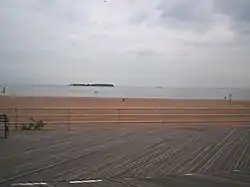Swinburne Island
Swinburne Island is a 4-acre (1.6 ha) artificial island in Lower New York Bay, east of Staten Island in New York City. It was used for quarantine of immigrants. Swinburne Island is the smaller of two nearby islands, the other being Hoffman Island to the north.




History
After several cholera pandemics in the nineteenth century, the federal government built Swinburne Island and Hoffman Island to serve as areas of quarantine for immigrants arriving by ship and carrying contagious diseases.[1] Along with Hoffman Island, which was constructed in 1873, Swinburne was used through the early 20th century to quarantine immigrants to the United States who were found to be suffering dangerous contagious diseases upon arrival at the Port of New York. Immigrants suspected of having such diseases were taken to the quarantine hospital and were not allowed to go to Ellis Island for entry until they were shown to be well or were cured of the disease. The island was used to quarantine patients during the last cholera outbreak in the United States in 1910–1911, which started with a passenger from Naples on the Moltke, a ship of the Hamburg-American line.[2][3] Swinburne was the second built, about a mile south of the earlier island, and it has a crematorium. The island was originally called Dix Island, but was renamed in honor of Dr. John Swinburne (1820–1899), a military surgeon during the American Civil War.[4][5]
During World War I, immigration was reduced. Later, the United States passed the Immigration Act of 1924, which sharply lessened immigration from southern and eastern Europe. By this time, the city and state had learned other means of controlling infectious diseases, so the quarantine facilities were little used.
By the start of World War II, the United States Merchant Marine had adapted both islands as a training station, which had opened in 1938.[6]
Current use
Both Hoffman Island (11 acres) and Swinburne Island (4 acres) are now managed by the National Park Service as part of the Staten Island Unit of Gateway National Recreation Area.
Hoffman Island features the remains of deserted docks, and its interior is densely overgrown, revealing only the foundations of demolished structures. Swinburne Island, on the other hand, displays five substantial dilapidated buildings. Among these ruins stands a brick chimney, likely associated with the former crematorium.[7]
They are not open to the public, and as The NY Times reported, “Paradoxically, then, though the islands belong to the Gateway National Recreation Area, the only recreation permitted is practiced by visitors of the feathered and aquatic persuasions.”[7] Within the past decade, Swinburne Island has become a popular haul out site for Lower New York Harbor's population of harbor seals and grey seals. The populations of both species have been increasing every year.[8] There are also nesting site for five species of long-legged wading birds.[7]
References
- "Quarantine At New York". Harper's Weekly. September 6, 1879. Retrieved 2008-07-28.
April 23, 1863, what is now known as the General Quarantine Act was passed, defining the quarantine establishment, authorizing its construction, creating the permanent office of Quarantine Commissioner, defining the duties and powers of the Commissioners and Health Officer, and establishing a general system of quarantine for the port. Additional powers were conferred by amendments made to this general act in 1864, 1865, 1866, and 1867, under which two small steamers were purchased; the property at Tompkinsville, Staten Island, known as the Marine Hospital Grounds, was sold; and the artificial islands in the lower bay were undertaken and afterward completed — Swinburne Island in 1870, and Hoffman Island in 1873.
- "More Cholera in Port". Washington Post. October 10, 1910. Archived from the original on 2008-12-16. Retrieved 2008-12-11.
A case of cholera developed today in the steerage of the Hamburg-American liner 'Moltke,' which has been detained at quarantine as a possible cholera carrier since Monday last. Dr. A.H. Doty, health officer of the port, reported the case tonight with the additional information that another cholera patient from the 'Moltke' is under treatment at Swinburne Island.
- "Cholera Kills Boy. All Other Suspected Cases Now in Quarantine and Show No Alarming Symptoms" (PDF). New York Times. July 18, 1911. Retrieved 2008-07-28.
The sixth death from cholera since the arrival in this port from Naples of the steamship Moltke, thirteen days ago, occurred yesterday at Swinburne Island. The victim was Francesco Farando, 14 years old.
- Swinburne was born on May 30, 1820 and he died on April 4, 1889
- Poole, M. O. (February 28, 1937). "Historic Islands At New York's Front Door". New York Times. Retrieved 2008-07-28.
When the Federal Government recently offered to give Hoffman and Swinburne Islands to the City of New York not a few people asked where these islets might be found and for what purposes they had been used. Hoffman and Swinburne are man-made islands and they lie at the entrance of the Narrows, west of the main ship channel, a mile off the Staten Island shore. Hoffman Island, nine and three-tenths ... This was afterward changed to Swinburne in honor Of Dr. John Swinburne, ...
- Kenneth T. Jackson: The Encyclopedia of New York City: The New York Historical Society; Yale University Press; 1995. P. 149.
- Gill, John Freeman (2020-05-22). "Islands Created for Quarantines". The New York Times. ISSN 0362-4331. Retrieved 2023-09-14.
- Newman, Andy (25 March 2006). "Swimmers From the North Delight Scientists and Sightseers". The New York Times. Retrieved 30 January 2019.
External links
![]() Media related to Swinburne Island at Wikimedia Commons
Media related to Swinburne Island at Wikimedia Commons
- Harbor Herons Project, NYC Audubon
- Harbor Herons Nesting Survey -recent reports on wading bird, cormorant, and gull nesting activity at Swinburne Island
- A Satellite Photo of the two islands, Google Maps
- The Forgotten Of Ellis Island: Deaths in Quarantine, 1909–1911

